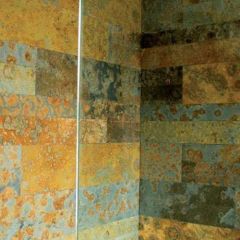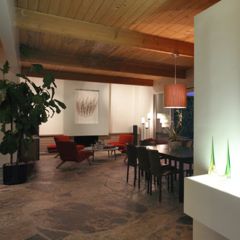Slate
Slate Slabs & Slate Tiles
Slate is formed of compressed layers of sediments formed under ocean. Slate is a regionally metamorphosized, argillaceous rock, that has developed but has suffered re-crystallization and compressed into a dense stone made up of quartz, iolite, mica and calcite. Because it is formed in layers, it can easily be split to expose beautifully textured surfaces. Slate splits naturally into beautifully textured layers. The usual colors of slates are earthy (various shades and mixes of browns, beiges, yellows) black, dark-grays, and greenish-gray but shades of pinks, purples and copper are also found. They usually exhibit lot of variations amongst the pieces quarried from the same pit.
Natural Cleft
Unique to slate, it has a slightly uneven surface that is still usable for flooring. This finish cannot be created, but occurs naturally as the layers of slate are quarried. One side (back side) can be gauged to facilitate ease of “thin set” installation. Some marbles, sandstones and limestones are available with heavy clefting, suitable for wall installations only.
Gauged vs. Ungauged
Slate is cleft out of blocks to form tiles. When it is cleft by machine or saw, it is gauged because a uniform thickness is formed. Ungauged stone is hand-cleft and its thickness may vary up to 5/8 of an inch.
Slate Usability
Slate products are durable and stain-resistant and have been used (depending on their individual hardness) for flooring, cladding and landscaping for many years. The vibrant colors and unique texture makes slates appropriate for interior as well as exterior applications, in both residential and commercial projects.
Is Cleft Finished Slate A Tripping Hazard?
Slate with a heavily cleft finish may create a tripping hazard. Most slates are lightly clefted and suitable for flooring in kitchens, bathrooms and on patios. A pallet of slate may contain a few pieces with heavy clefting, but these are generally not used for the flooring installation.
NEVER BUTT JOINT SLATE TILES
Natural Slate Maintenance
• After installation of your new slate, use a penetrating sealer to prevent staining. Because slate is quite porous, excessive water may cause reactions such as oxidation (rust), spalling, deterioration of dry veins, etc. Impregnating Sealers are recommended in regular bases, to avoid these problems.
• Clean your slate (regularly)with a dust mop and neutral cleaner to remove most dirt.
• To clean heavier soiled area in your Natural Slate use Stone Cleaners, PH Balanced Cleaners or Neutral Base Cleaners, when needed.
• Avoid using any acidic cleaners including vinegar or cleaners containing lemon or lime. These products will abrade the polish from the stone. Keep in mind that sealers don't protect polished surfaces from these types of cleaners.


